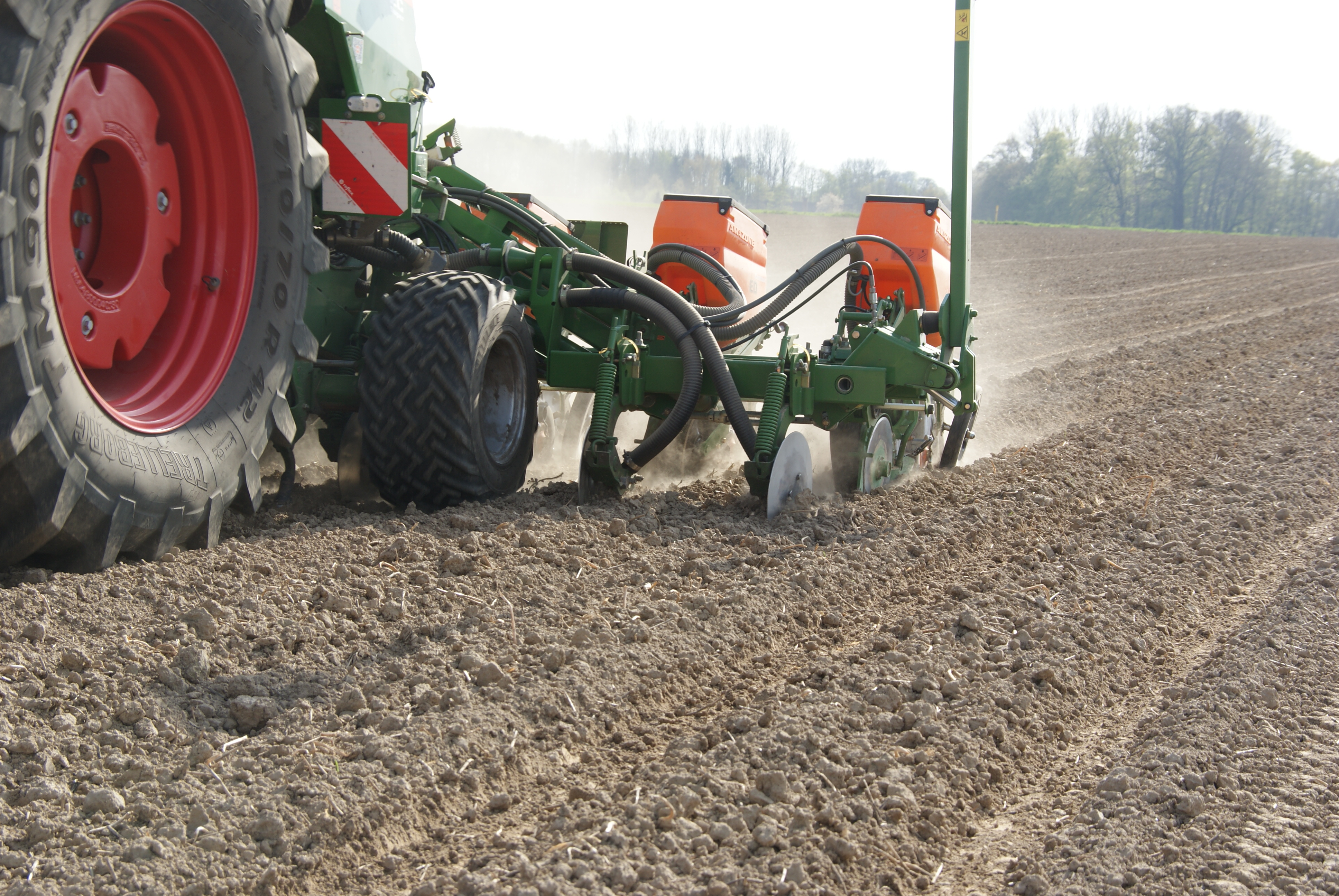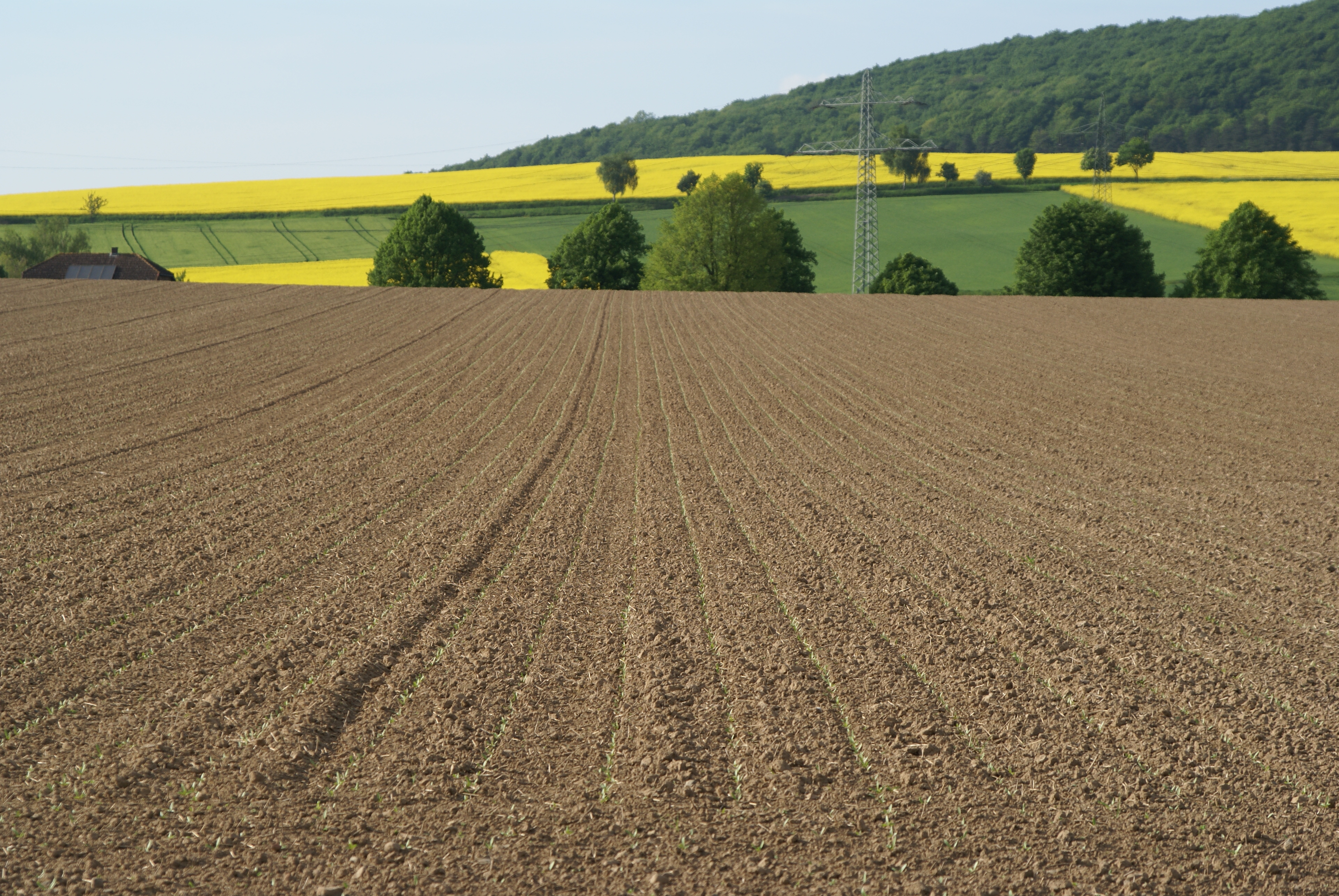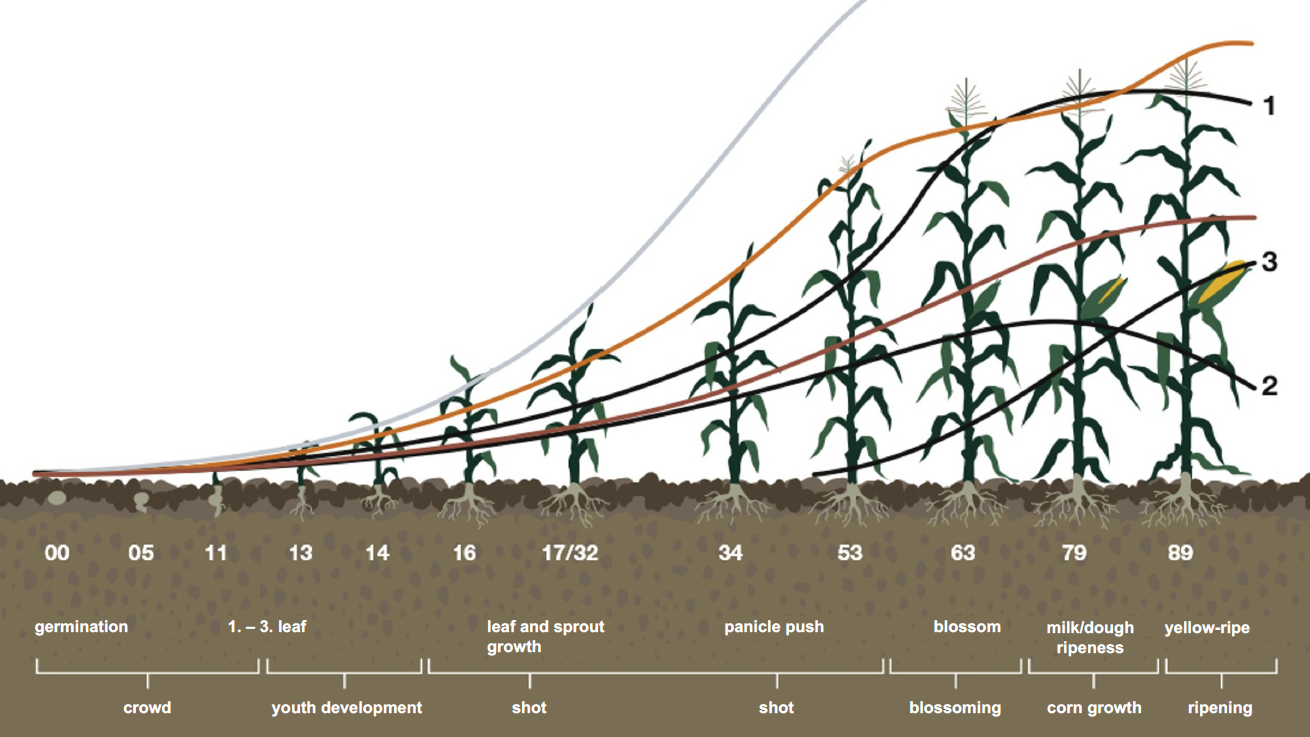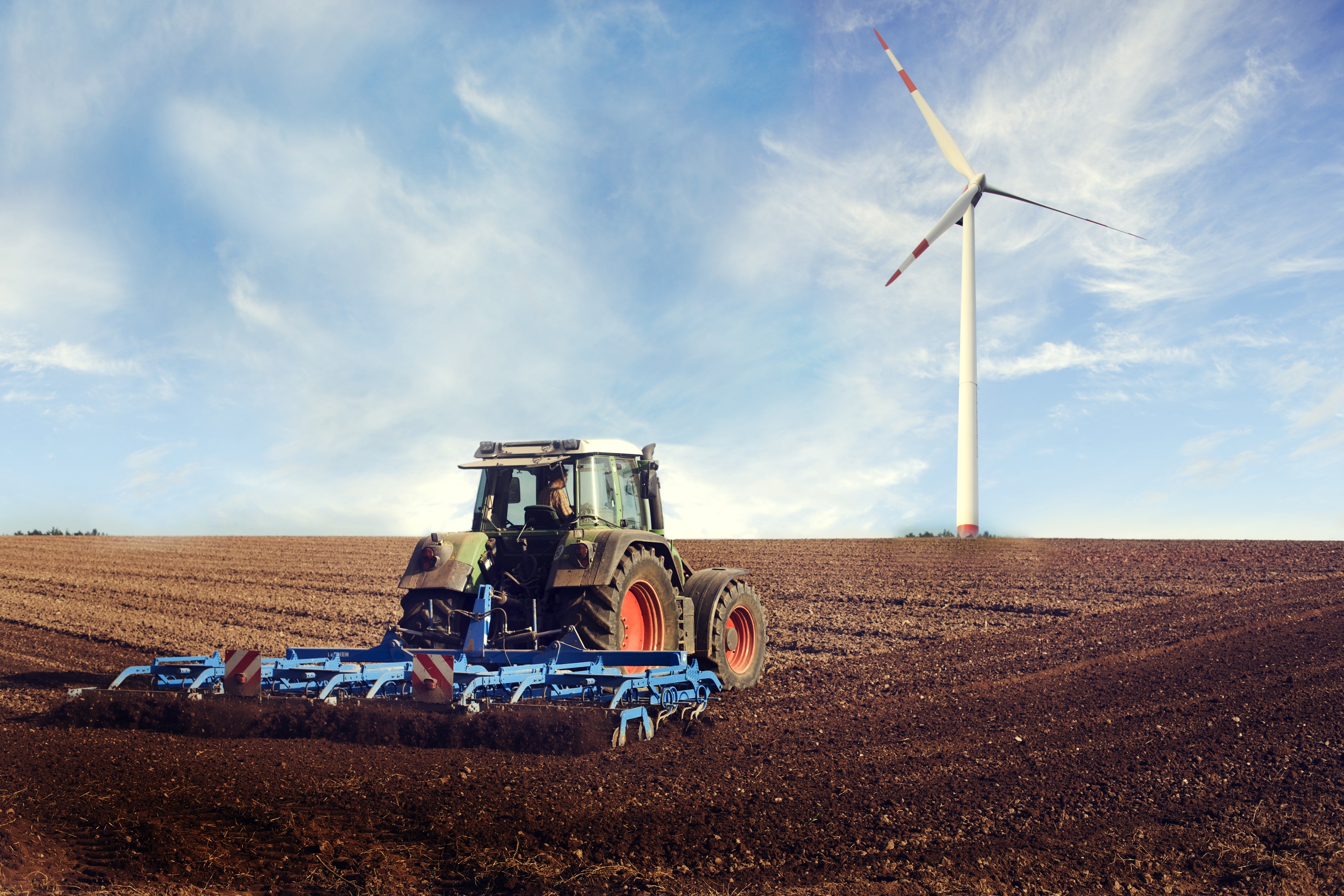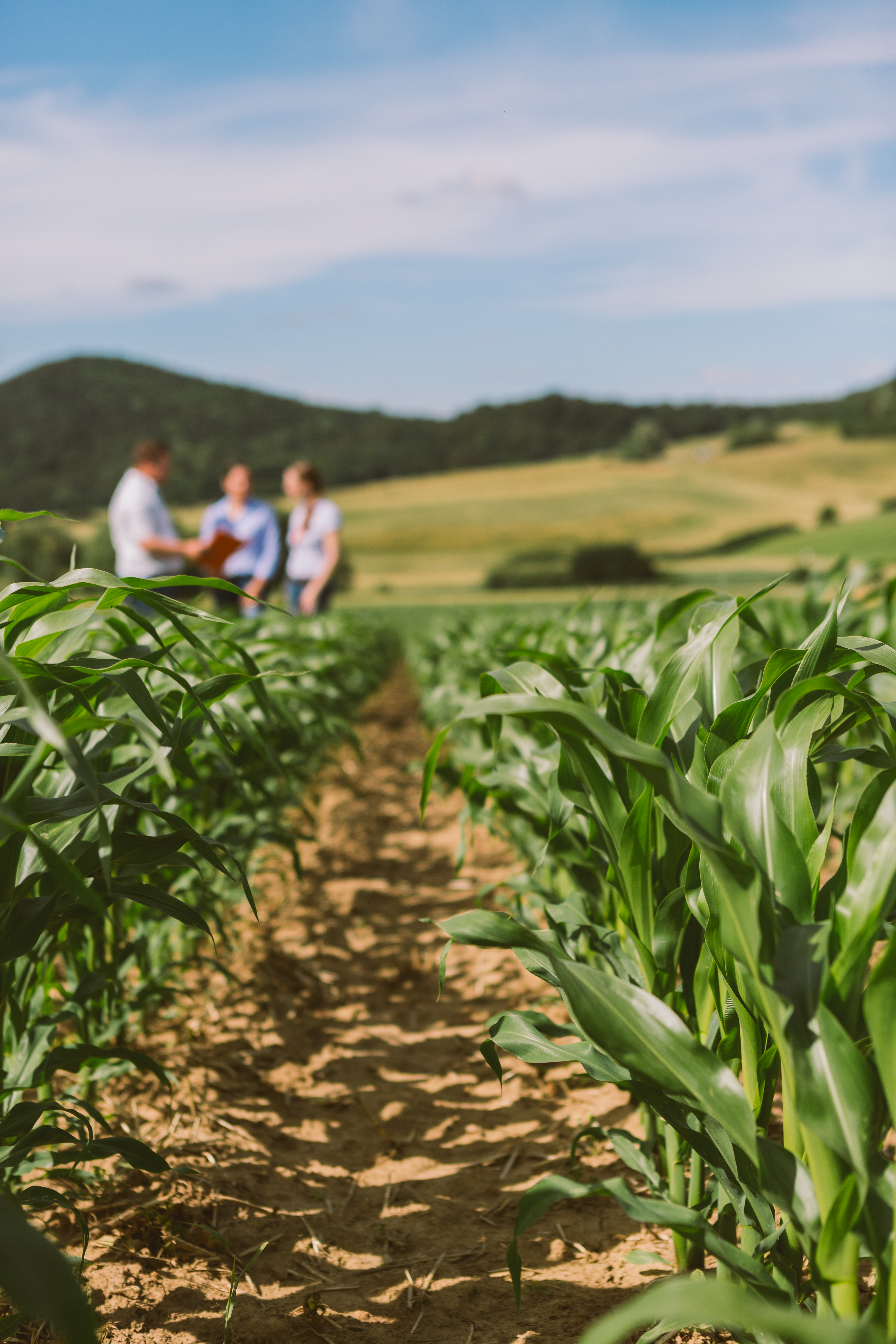The most important facts on tillage - for your success in maize cultivation!
1. The right pH-value - indispensable for your success!
Maintaining the “right” pH-value is essential for achieving high yields and qualities in the case of maize cultivation as well. The pH-value provides information on the lime supply of the soil. The lime requirement depends on the current pH-value, the humus content and the soil type. Early spring and pre-sowing fertilisation with fast-acting lime types have proven to be worth recommending (e.g., pre-seeding liming with 1.7 t CaO/ha).
The following pH-value targets should be aimed for:
|
Soil type |
Target pH-value and maintenance liming (kg/ha CaO) depending upon the humus content |
maximum lime input per year in kg/ha CaO |
||||
|---|---|---|---|---|---|---|
|
up to 4%, low or medium humus content |
4.1-8% high humus content |
8.1-15% very high humus content |
15.1-30% mucky |
more than 30% Bog** |
||
|
S |
5.6 600 |
5.2 500 |
4.8 400 |
4.3 200 |
4.1 0 |
1000 |
|
IS, sU |
6.0 900 |
5.6 800 |
5.2 700 |
4.8 300 |
- |
1500 |
|
ssL, IU |
6.4 1100 |
6.0 900 |
5.6 700 |
5.1 400 |
- |
2000 |
|
sL, uL, L |
6.8 1300 |
6.3 1100 |
5.8 900 |
5.2 500 |
- |
3000 |
|
utL, tL, T |
7.0 1600 |
6.5 1500 |
6.0 1200 |
5.4 600 |
- |
4000 |
* The recommended lime quantities are based on a three-year crop rotation with moderate yield levels at 850 mm annual precipitation
** The lime recommendation for boggy locations are based on high moor; low moor sites generally have pH-values of 6 - 6.5 and do not require liming.
Source: LWK North Rhine-Westphalia
2. The right temperature does the trick - temperature requirements for maize
Temperature fluctuations are greater in light soils than in heavy soils. Especially cold periods in the young plant phase can permanently affect the development of the maize, particularly in the 6-8 leaf stage.
Possible consequences include:
- Damage to maize crops
- Irregular pollination
- Fewer rows of maize per ear
- Complete reduction of the main ear
When the first ear dies off, a second ear can be formed. However, the development of the second ear is delayed and therefore inadequate pollination may take place (lower crossover of male and female flowers). In extreme cases, a second ear is not formed, resulting in reduced yields.
Agronomic countermeasures:
- Intact soils with good soil structure
- Sufficient nutrient supply
- Balanced nutrient content
- Avoidance of herbicidal actions in the presence of high temperature fluctuations
Up to the 6-leaf stage, cold spells can cause temporary phosphate deficiency with violet discolourations. Negative effects on the yield are not feared concern.
In describing the suitability of the site for maize cultivation, average temperatures during the growth period and the heat sum are often used.
Suitability for cultivation of varieties of the various maturity groups depending on average temperatures and heat sums
|
|
Average temp. September in °C |
according to AGPM, basis 6°C |
||||
|
maturity group |
Silage maize |
Grain maize |
Silage maize at % DM |
Grain maize at % DM |
||
|
early |
12.5°C - |
13.5 °C - |
at 32% at 35% |
1.450°C 1.500°C |
at 65% - |
1.600 °C - |
|
moderately early |
13.5 °C - |
14.5 °C - |
at 32% at 35% |
1.490 °C 1.540 °C |
at 65% - |
1.650 °C - |
|
moderately late |
14.5 °C - |
15.0 °C - |
at 32% at 35% |
1.530 °C 1.580 °C |
at 65% - |
1.670-1730 °C |
|
late |
15.5 °C |
15.0 °C |
at 32% |
approx. 1.590 °C |
at 70% |
|
Source: our own Calculation according to AGPM 2017
3. Water requirement of maize
Compared with other crop plants, maize has a low water requirement for producing dry mass. Maize requires 300 L water to produce 1 kg dry mass. This value is also called the transpiration coefficient.
A compilation of the transpiration coefficients of the various crop types shows the different water requirements:
| Transpiration coefficient (l water/kg TM) | Type of crops |
| 200–300 | Millet (sorghum) |
| 300-400 | Maize, beet |
| 400–500 | Barley, rye, durum wheat |
| 500–600 | Potato, sunflower, common wheat |
| 600–700 | Rapeseed, pea, field bean, oats |
Source: BOKU [University of Natural Resources and Life Sciences] Vienna
- Well nourished plants basically have a higher water acquisition capacity
- Potassium is of particular significance, since it has a positive effect on the water balance of plants
- Maize has the highest water requirement (up to 6 mm per m² and day) from plume emergence to milk development.
Through tilling, Variety selection, plant density, sowing date and Fertilisation production technology strategies against water stress can be applied.
Effects of water deficiency
- Up to the start of flowering: Impairment of growth and ear formation
- During flowering + hot spells: inadequate pollination
- After pollination: Limitation of assimilate relocation to the grain
4. Nutrient removal and course of nutrient uptake in maize
Because of its slow development in young stages, maize has a late-starting nutrient requirement, but the total withdrawal is considerable because of the high yield potential. Since the yield predictions can come out quite differently based on the site-specific data, the required nutrient quantities also exhibit considerable variability.
Nutrient matter (kg/ha per 10 dt grain maize [86% DM] or 100 dt silage maize fresh mass [28 % DM]:
|
|
Silage maize (28% DM) |
Grain maize (86% DM) |
|
|
Nutrient |
per 100 dt fresh mass |
Grains (10 dt) |
Straw (10 dt) |
|
Nitrogen (N) |
30-40 |
12-16 |
5-9 |
|
Phosphate (P205) |
15-25 |
6-11 |
5-7 |
|
Potassium (K20) |
35-50 |
4-6 |
15-25 |
|
Magnesium (MgO) |
7-13 |
2-3 |
2-4 |
|
Lime (CaO) |
10-18 |
2-3 |
5-7 |
|
Sulphur (S) |
3.5 |
- |
- |
Source: From Früchtenicht et al., 1993
In addition to these average values for nutrient withdrawal, the following aspects are important:
- The nutrient requirement fluctuates greatly depending on the specific circumstances and predicted yield
- Adequate supply of micronutrients
- Soil testing results
In addition to the principal nutrients (nitrogen, phosphate, potassium, magnesium, calcium), the addition of sulphur and micronutrients will also be discussed. The sulphur and nitrogen requirements are closely associated, since these two are bound in the plant protein in a 1:10 ratio. Therefore mineral fertilisation with sulphur is reasonable, e.g., with SSA in the underfoot fertiliser. One positive side effect is the acidifying effect of SSA, resulting in an increase in pH-value availability in soils with high pH-values. To prevent damage to the small maize plants, sulphur as an underfoot fertiliser should be placed no less than 5 cm below and 5 cm to the side of the grain.
Recommended fertilisation
The level of fertilisation depends on the nutrient content of the soil and the expected yield level. A fertilisation plan according to the Fertilisation Ordinance is to be executed for each campaign. The table below provides reference values:
| Type | Quantity (kg/ha) | Application time |
| Nitrogen fertilisation (N) | 140-220 | before sowing, underfoot, before or after sprouting |
| Phosphate fertilisation P205 | 40-80 | underfoot |
| Potassium fertilisation K20 | 200-250 | before sowing (spring, fall) |
| Sulphur fertilisation | 30-40 | before sowing, underfoot, before or after sprouting |
| Magnesium fertilisation | 40-70 | before sowing, underfoot, before or after sprouting |
Source: KWS SAAT SE & Co. KGaA
The time of maximum nutrient removal extends from about 10-15 days before flowering to 25-30 days after flowering. During this period 85% of the nitrogen requirement, 73% of the phosphate requirement and 96% of the potassium requirement are absorbed. Nitrogen and phosphate are also still being withdrawn during ear ripening. The potassium uptake is completed by then.
Do you want more information on the topic of Fertilisation? KWS has compiled some aspects for you.
Course of nutrient uptake (statements in percent)
Source: Herrmann, 2010
|
Stage |
N |
P205 |
K20 |
MgO |
S |
|
to 4-leaf stage |
2% |
1% |
4% |
3% |
2% |
|
4-leaf stage to drying of the silk |
85 % |
73% |
96% |
78% |
85 % |
|
Ear ripeness |
13% |
26% |
0% |
19% |
13% |
